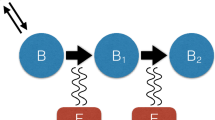Abstract
We analyze the notion of quantum capacity from the perspective of algorithmic (descriptive) complexity. To this end, we resort to the concept of semi-computability in order to describe quantum states and quantum channel maps. We introduce algorithmic entropies (like algorithmic quantum coherent information) and derive relevant properties for them. Then we show that quantum capacity based on semi-computable concept equals the entropy rate of algorithmic coherent information, which in turn equals the standard quantum capacity. Thanks to this, we finally prove that the quantum capacity, for a given semi-computable channel, is limit computable.
Similar content being viewed by others
Notes
Semi-density matrix is a broader notion with respect to the density matrix, in that it conceives positive matrices with trace not necessarily equal to 1, although finite.
Throughout, the paper the \(\log \) is intended on base 2.
Example: Let us consider the subset A of all limit computable numbers between 0 and 1 which are represented as binary numbers. We can enumerate them by a Turing machine as \(\psi _1, \psi _2, \ldots , \psi _k, \ldots \). We denote by \(\epsilon _k=0. \psi _k (1) \psi _k (2) \ldots \psi _k (n) \ldots \) the kth element of A being \(\psi _k(n)\) the nth digit of \(\epsilon _k\). Now, consider a number \(\lambda \in [0,1]\) whose nth digit is equal to \(\psi _n (n)+1\) modulo 2. It is obvious that \(\lambda \) is different of any \(\epsilon _k\), and so \(\lambda \) is non-limit computable. The set of such \(\lambda \)’s is clearly uncountable.
Following [4], the embedding is obtained by turning the last bit of each canonical basis element to 0.
References
Wilde, M.M.: Quantum Information Theory. Cambridge University Press, Cambridge (2013)
Zvonkin, A.K., Levin, L.A.: The complexity of finite objects and the development of the concepts of information and randomness by means of the theory of algorithms. Russ. Math. Surv. 25, 83 (1970)
Gacs, P.: Quantum algorithmic entropy. J. Phys. A: Math. Theor. 34, 6859 (2001)
Benatti, F., Oskouei, S.K., Deh Abad, A.S.: Gacs quantum algorithmic entropy in infinite dimensional Hilbert spaces. J. Math. Phys. 55, 082205 (2014)
Oskouei, S.K.: Gacs algorithmic complexity in infinite Hilbert spaces and its applications. Ph.D. dissertation, University of Tehran (2015)
Solomonoff, R.: A formal theory of inductive inference. Inf. Control 7, 224 (1964)
Kolmogorov, A.: Three approaches to the quantitative definition of information. Probl. Inf. Transm. 1, 1 (1965)
Chaitin, J.G.: On the length of programs for computing finite binary sequences. J. ACM 13, 547 (1966)
Berthiaume, A., van Dam, W., Laplante, S.: Quantum Kolmogorov complexity. J. Comput. Syst. Sci. 63, 201 (2001)
Vitanyi, P.: Quantum Kolmogorov complexity based on classical descriptions. IEEE Trans. Inf. Theory 47, 2464 (2001)
Mora, C.E., Briegel, H.J.: Algorithmic complexity and entanglement of quantum states. Phys. Rev. Lett. 95, 200503 (2005)
Wolf, M.M., Cubitt, T.S., Perez-Garcia, D.: Are problems in Quantum Information Theory (un)decidable? arxiv.org/abs/1111.5425 (2011)
Cubitt, T., et al.: Unbounded number of channel uses may be required to detect quantum capacity. Nat. Commun. 6, 6739 (2015)
Stinespring, W.F.: Positive functions on \(C^*\)-algebras. Proc. Am. Math. Soc. 6, 211 (1955)
Devetak, I.: The private classical capacity and quantum capacity of a quantum channel. IEEE Trans. Inf. Theory 51, 44 (2005)
Hayden, P., Horodecki, M., Winter, A., Yard, J.: A decoupling approach to the quantum capacity. Open Syst. Inf. Dyn. 15, 7 (2008)
Lindblad, G.: Completely positive maps and entropy inequalities. Commun. Math. Phys. 40, 147 (1975)
Davis, M., Sigal, R., Weyuker, E.J.: Computability, Complexity, and Languages: Fundamentals of Theoretical Computer Science. Academic Press, San Diego (1994)
Choi, M.D.: Completely positive linear maps on complex matrices. Linear Algebra Appl. 10, 285 (1975)
Author information
Authors and Affiliations
Corresponding author
Rights and permissions
About this article
Cite this article
Oskouei, S.K., Mancini, S. Algorithmic complexity of quantum capacity. Quantum Inf Process 17, 94 (2018). https://doi.org/10.1007/s11128-018-1859-0
Received:
Accepted:
Published:
DOI: https://doi.org/10.1007/s11128-018-1859-0




